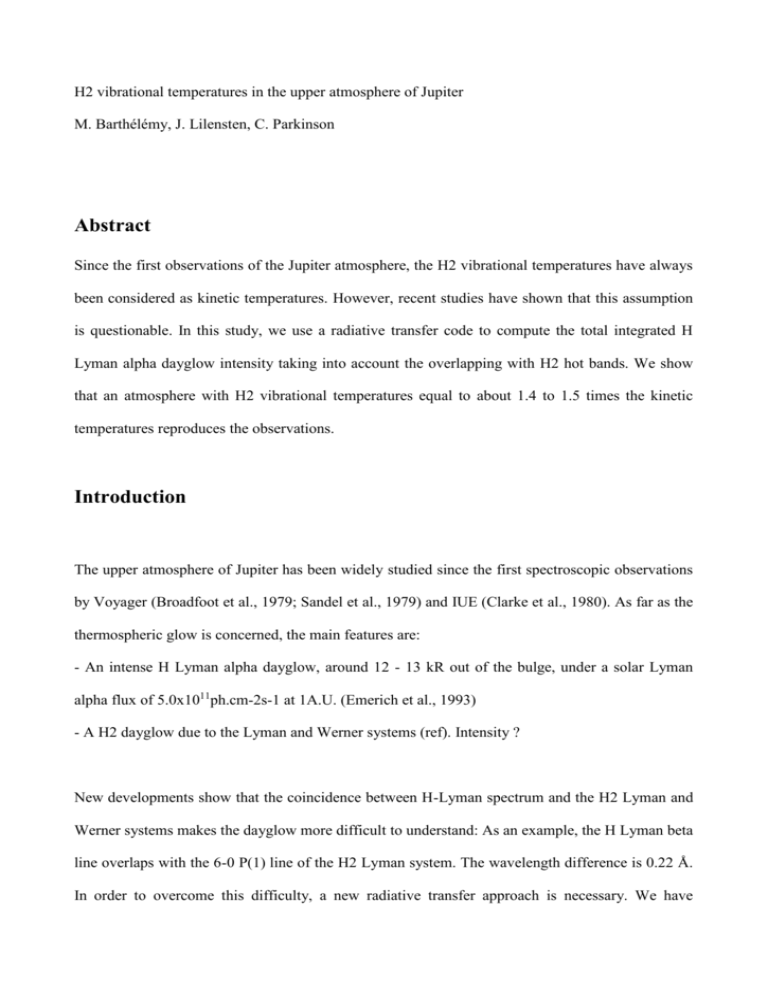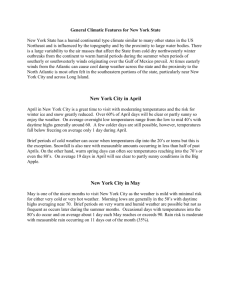H2 vibrational temperatures in the upper atmosphere of Jupiter
advertisement

H2 vibrational temperatures in the upper atmosphere of Jupiter M. Barthélémy, J. Lilensten, C. Parkinson Abstract Since the first observations of the Jupiter atmosphere, the H2 vibrational temperatures have always been considered as kinetic temperatures. However, recent studies have shown that this assumption is questionable. In this study, we use a radiative transfer code to compute the total integrated H Lyman alpha dayglow intensity taking into account the overlapping with H2 hot bands. We show that an atmosphere with H2 vibrational temperatures equal to about 1.4 to 1.5 times the kinetic temperatures reproduces the observations. Introduction The upper atmosphere of Jupiter has been widely studied since the first spectroscopic observations by Voyager (Broadfoot et al., 1979; Sandel et al., 1979) and IUE (Clarke et al., 1980). As far as the thermospheric glow is concerned, the main features are: - An intense H Lyman alpha dayglow, around 12 - 13 kR out of the bulge, under a solar Lyman alpha flux of 5.0x1011ph.cm-2s-1 at 1A.U. (Emerich et al., 1993) - A H2 dayglow due to the Lyman and Werner systems (ref). Intensity ? New developments show that the coincidence between H-Lyman spectrum and the H2 Lyman and Werner systems makes the dayglow more difficult to understand: As an example, the H Lyman beta line overlaps with the 6-0 P(1) line of the H2 Lyman system. The wavelength difference is 0.22 Å. In order to overcome this difficulty, a new radiative transfer approach is necessary. We have developed such a code, which takes into account the overlapping (Barthélémy et al., 2003). This code allows to discriminate the column density of the atomic and molecular hydrogen and gives information on their kinetic temperatures. Spectroscopic studies (Abgrall et al., 1993) show that the H2 Lyman system has several lines of hot bands that are in coincidences with H Lyman alpha. Namely, 1-2 R(6) and 1-2 P(5). These coincidences have been observed in Hernig - Haro objects (HH47, Curiel et al., 1995). The energy of the vibrational level v=2 is very high: E = 8086 cm-1 which corresponds to a temperature of about 12 000 K. If the vibrational temperatures are equal to the kinetic ones, the population of this level remains quite negligible. However, the densities and temperatures that exist in the upper atmosphere of Jupiter make the Local Thermodynamic Equilibrium (LTE) impossible to maintain. Several authors suggest that the vibrational temperatures are larger than the kinetic temperatures (Parkinson, 2002; reference 2) by a factor 1 to 4. The effect would then be to populate the v = 1 or v = 2 vibrational levels of the X1g+ electronic state. Wolven et al. (1997) have measured a fluorescence induced by the solar Lyman alpha line of about 100 R before the Shomaker - Levy 9 impact. This is the only observation available. We aim at checking whether it is coherent with the assumption of an enhanced vibrationnal temperature. 1. METHOD It is based on the work by Gladstone (1983). It has been upgraded by Gladstone (1988) to study other lines including Lyman beta. Vervack et al. (1995) used it to study the He 584 Å line and to explain the Voyager observations. Griffoen (2001) and Parkinson (2002) upgraded of the code by including the case of several overlapping lines to study the H-D case for Lyman alpha. It has recently been used to describe the Lyman beta Jupiter emission line (Barthélemy et al., 2003). The formalism is based on the 1-D radiative transfer equation considering the frequency redistribution. It makes use of the Feautrier technique described in detail by Mihalas (1978), Gladstone (1983), Cannon (1985) and Griffioen (2001). The inputs are: - the neutral atmosphere (Parkinson; 2002). We consider 3 species. At low altitude (between 500 km and 2000 km above the 1 bar level), the molecular hydrogen is the main species. At higher altitudes, the atomic hydrogen becomes more abundant because of the H2 photodissociation. Finally, CH4 cannot be neglected close to 500 km high. The exospheric temperature is from the Galileo probe measurements. It is 1100 K. The profile is based on the deceleration measurements of same probe (Seiff et al., 1997). (fig. 1) Figure 1: Jovian atmospheric model. Up: composition. Down: temperature. - the solar activity level: the present case corresponds to a quiet solar activity. - - The solar input flux which is modelled with a double gaussian. Its intensity is 5.0x1011 ph cm2s-1 at 1A.U. The line width and the offset from the line centre of each peak are respectively ??? - The spectroscopic parameters. For the atomic hydrogen Lyman beta line we take the parameters of Gladstone (1988). The parameters for the molecular hydrogen line are from Abgrall et al. (1993). They are summarised in table 1. Because of the lack of height profiles information, we consider a mean vibrational temperature over all the altitudes. The main outputs of the code are the line profiles and the integrated intensity (in Rayleigh). 2. RESULTS We first consider the case with equal kinetic and vibrational temperatures. The line profile is shown in figure 2. Figure 2: Lyman alpha line profile with vibrational temperatures 1,2 (up) or 4 (down) times higher than kinetic temperatures. The wavelength has been centred on 0 (its value is 1215.69 Å). The H Lyman alpha integrated intensity is 12.80 kR at the centre of the disc, which is coherent with the Voyager observations (Emerich et al., 1993). The profile itself is coherent with previous calculations by Gladstone et al. (1988) and Griffioen (2001). We now introduce vibrational temperatures that vary between 1 to 4 times the kinetic ones. The effect on the profile is shown in figure 2: on the red side, an absorption occurs which lower the profile up to 109 photons/cm2/sr/s/Angstrom with vibrational temperatures equal to 4 times the kinetic temperatures. The total intensity at the centre of the disk is respectively 12.80 kR, 12.08 kR, 11.14 kR and 10.85 kR for multiplication factors of 1, 2, 3 and 4. Wolven et al. (1997) have measured a fluorescence induced by the solar Lyman alpha line of about 100 R before the Shomaker - Levy 9 impact. The multiplication factor that reproduces this difference on the Lyman alpha dayglow is between 1.4 and 1.5. The corresponding intensities are respectively 12.72 kR and 12.66 kR. It is not necessary to reach a better precision since we apply a constant factor all along the altitudes. The important point is that from this approach, there is already a departure of the vibrational temperature from the kinetic temperature although the atmospheric temperatures are not as high as in the HH 47 objects. The line profile does not show any significant change at the centre of the disk. However, at the limb, the 1.4 factor introduces a slight decrease of the red side of the line profile (figure 3). figure 3: Lyman alpha line profile with vibrational temperature 1.4 higher than kinetic temperature. We note the little absorption peak on the red side of the line. CONCLUSION Since the first observations of the Jupiter atmosphere, the temperature has always been considered as kinetic temperatures. This is because the overall temperature is relatively small (the exospheric temperature is about 1100 K). At the time of the SL 9 impact, the Wolven et al. (1997) observation have raised the question of this assumption. Through a radiative transfert approach, we have shown that these observations are coherent with vibrational temperatures equal to about 1.4 to 1.5 times the kinetic temperatures. The excitation mechanisms remain to be explained. Coupling the radiative transfer approach with a particle collision code can do this. In the future, more precise correction factors for the vibrational temperature will be obtained by comparing the computed line profiles with observations.






